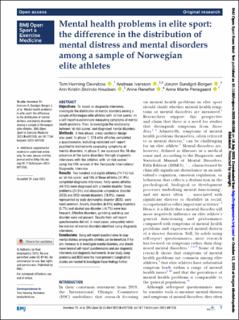| dc.contributor.author | Øvrebø, Tom Henning | |
| dc.contributor.author | Ivarsson, Andreas | |
| dc.contributor.author | Sundgot-Borgen, Jorunn | |
| dc.contributor.author | Knudsen, Ann Kristin Skrindo | |
| dc.contributor.author | Reneflot, Anne | |
| dc.contributor.author | Pensgaard, Anne Marte | |
| dc.date.accessioned | 2023-10-24T08:02:14Z | |
| dc.date.available | 2023-10-24T08:02:14Z | |
| dc.date.created | 2023-08-31T11:39:37Z | |
| dc.date.issued | 2023 | |
| dc.identifier.citation | BMJ Open Sport & Exercise Medicine. 2023, 9(3), Artikkel e001538. | en_US |
| dc.identifier.issn | 2055-7647 | |
| dc.identifier.uri | https://hdl.handle.net/11250/3098243 | |
| dc.description | This is an open access article distributed in accordance with the Creative Commons Attribution Non Commercial (CC BY-NC 4.0) license, which permits others to distribute, remix, adapt, build upon this work non-commercially, and license their derivative works on different terms, provided the original work is properly cited, appropriate credit is given, any changes made indicated, and the use is non-commercial. | en_US |
| dc.description.abstract | Objectives: To, based on diagnostic interviews, investigate the distribution of mental disorders among a sample of Norwegian elite athletes with ‘at-risk scores’ on a self-report questionnaire measuring symptoms of mental health problems. Then, to investigate the relationship between ‘at-risk scores’ and diagnosed mental disorders.
Methods: A two-phase, cross-sectional design was used. In phase 1, 378 elite athletes completed a questionnaire, including validated self-report psychiatric instruments assessing symptoms of mental disorders. In phase 2, we assessed the 30-day presence of the same disorders through diagnostic interviews with the athletes with ‘at-risk scores’ using the fifth version of the Composite International Diagnostic Interview.
Results: Two hundred and eighty athletes (74.1%) had an ‘at-risk score,’ and 106 of these athletes (37.9%) completed diagnostic interviews. Forty-seven athletes (44.3%) were diagnosed with a mental disorder. Sleep problems (24.5%) and obsessive-compulsive disorder (OCD) and OCD-related disorders (18.9%), mainly represented by body dysmorphic disorder (BDD), were most common. Anxiety disorders (6.6%), eating disorders (5.7%) and alcohol use disorder (≤4.7%) were less frequent. Affective disorders, gambling and drug use disorder were not present. Results from self-report questionnaires did not, in most cases, adequately mirror the number of mental disorders identified using diagnostic interviews.
Conclusions: Using self-report questionnaires to map mental distress among elite athletes can be beneficial. If the aim, however, is to investigate mental disorders, one should move beyond self-report questionnaires and use diagnostic interviews and diagnostic instruments. In our study, sleep problems and BDD were the most prevalent. Longitudinal studies are needed to investigate these findings further. | en_US |
| dc.language.iso | eng | en_US |
| dc.subject | athlete | en_US |
| dc.subject | mental | en_US |
| dc.subject | psychiatry | en_US |
| dc.subject | psychology | en_US |
| dc.subject | sports medicine | en_US |
| dc.title | Mental health problems in elite sport: The difference in the distribution of mental distress and mental disorders among a sample of Norwegian elite athletes | en_US |
| dc.type | Peer reviewed | en_US |
| dc.type | Journal article | en_US |
| dc.description.version | publishedVersion | en_US |
| dc.rights.holder | © Author(s) (or their employer(s)) 2023 | en_US |
| dc.source.pagenumber | 9 | en_US |
| dc.source.volume | 9 | en_US |
| dc.source.journal | BMJ Open Sport & Exercise Medicine | en_US |
| dc.source.issue | 3 | en_US |
| dc.identifier.doi | 10.1136/bmjsem-2023-001538 | |
| dc.identifier.cristin | 2171344 | |
| dc.description.localcode | Institutt for idrett og samfunnsvitenskap / Department of Sport and Social Sciences | en_US |
| dc.description.localcode | Institutt for idrettsmedisinske fag / Department of Sports Medicine | en_US |
| dc.source.articlenumber | e001538 | en_US |
| cristin.ispublished | true | |
| cristin.fulltext | original | |
| cristin.qualitycode | 1 | |
